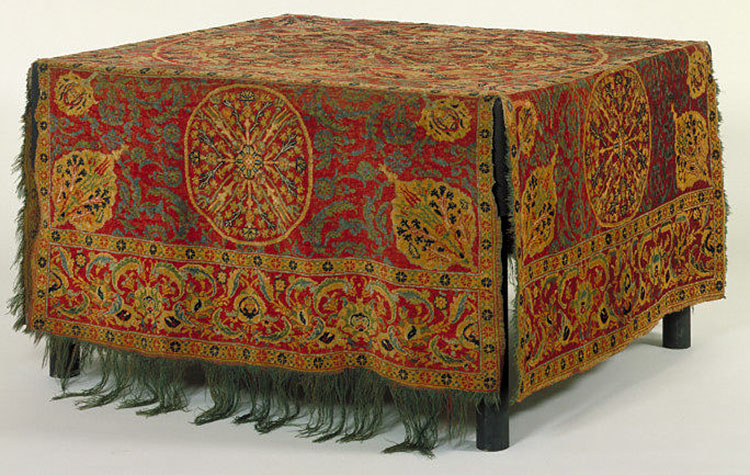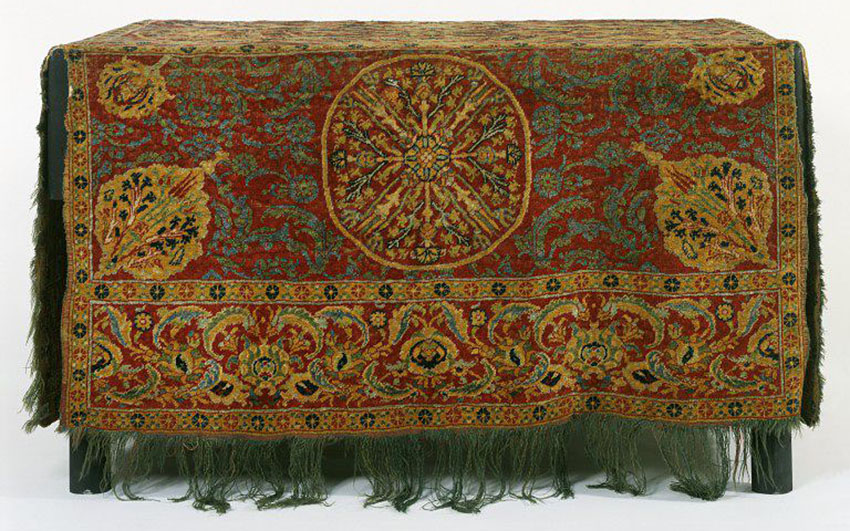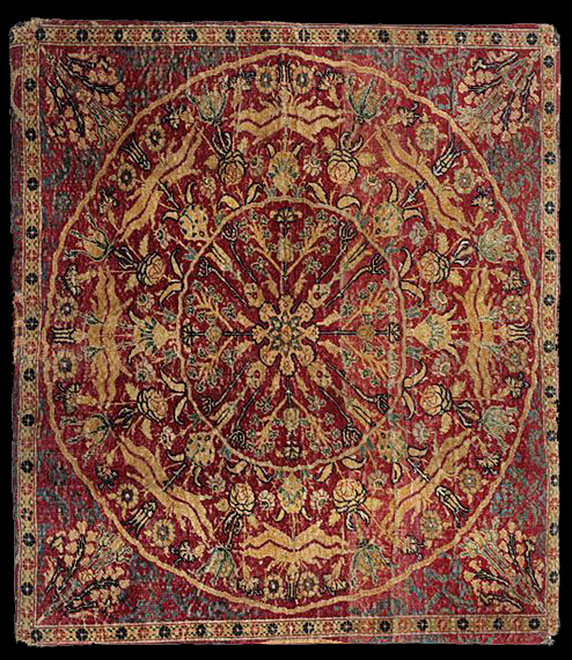|
Table carpet, Egypt or Turkey, 1550. Victoria and Albert Museum,
London, 151-1883
Place of origin: Turkey (probably, made)
Egypt (possibly, made)
Date: ca.1550 (made)
Artist/Maker:
unknown (production)
Materials and Techniques: Hand knotted woollen
pile, on woollen warp and
weft; asymmetrical knot, open to the
left; 195 knots per sq. in (3,000 per sq.
dm)
Museum number:
151-1883
Gallery location: Medieval and Renaissance, room 63, case
11
The threads used in the warp of this carpet were dyed
green so that they would form a coloured fringe as it hung over a
cube-shaped table. The warp was prepared so that the greatest width of
the carpet could be accommodated on the loom and the weavers tied
knots within the required outline. When the carpet was finished, the
excess warp threads were trimmed and secured.
Physical
description
Table Carpet, hand knotted woollen pile on woollen
warp and weft, woven to shape asymmetrical knot.
WARP: green and
yellow wool, often twisted together; S3Z; 26 threads per inch (100
cms); depressed.
WEFT: yellow wool and red wool; unable to
ascertain number of ply, but the threads are S-spun, Z-plied; 3 shoots
after each row of knots; 15 knots per inch (60 knots per dm).
PILE: wool; 8 colours: red, yellow, green, dark blue, blue, light
blue, brown, white; asymmetrical knot open to the left and tied around
2 threads; 195 knots per sq. inch (3000 per sq. dm).
SIDE FINISH:
Web of 9 cords (the outer one is composed of three warp threads and is
thicker than the others) worked with yellow wool; the outer cord is
oversewn with red wool.
END FINISH: Maximum of 8" (20.5 cms) loose
green warp ends.
DESIGN: Field: Central square: red ground
containing central roundel with carnations, hyacinths and tulips
coming out of central boss. Outer roundel has tulips, roses,
carnations, daisies and tiger stripes. Each corner contains a floral
spray.
Flaps: the four flaps have inner roundel as above but also
corner medallions with the blue/green carnations, hyacinths and tulips
on a yellow ground.
Main border: elaborate saz blossoms with
curling leaves on a red ground.
Narrow borders: which separate
flaps and field; bracketed blue and red blossoms on yellow.
Place of Origin
Turkey (probably, made)
Egypt (possibly,
made)
Date
ca.1550 (made)
Artist/maker
unknown (production)
Materials and Techniques
Hand
knotted woollen pile, on woollen warp and weft; asymmetrical knot,
open to the left; 195 knots per sq. in (3,000 per sq. dm)
Dimensions
Height: 89 cm, Width: 125 cm, Depth: 114 cm
Object history note
When purchased, this carpet was thought to
be a Persian canopy carried above a person of rank during processions.
Bought at the Bon Marche sale, Paris, through Mr. Purdon Clarke
Historical significance: Table carpets are normally round or
cruciform; this is the best-known example of the latter type.
Historical context note
Carpets like this were made in the East
Mediterranean for export to Europe (since tables were not a standard
item of furniture in the contemporary Islamic world).
Descriptive line
Table Carpet, hand knotted woollen pile on
woollen warp and weft, woven to shape asymmetrical knot, Turkey
(Ottoman), or possibly Egypt, mid-16th century
Bibliographic
References (Citation, Note/Abstract, NAL no)
Baker, Malcolm and
Richardson, Brenda, eds. A Grand Design : The Art of the Victoria and
Albert Museum, London, 1997, cat. no. 103. Yetkin (1981), illus. 64,
'Ottoman Court Carpet, cruciform table-cover, 16th century'. Dimand
(1973), illus. 187, 'Prayer rug, court manufactory, Bursa or Istanbul,
end of 16th or beginning of 17th century.' NB border floral
'palmettes'. Kuhnel and Bellinger (1957) pl 24, analysis p.45,
'Ottoman rugs from Cairo, middle of the 16th century' and plate 31,
and page 53, '... Cairo, early 17th century'. NB borders and analysis.
illustrated and mentioned 'E Mediterranean carpets in the V&A' by R.
Pinner and M. Franses (intro by Donald King), analysis by M. Franses.
Hali 1981 Vol.4 No.1 P. 36,45,47,49 Referred to in: Suebebhundert
Jahre Orientteppich by Kurt Erdmann, 1966, page 220 Historical Turkish
Carpets by Serare Yetkin, 1981, pge 105. The Persian Carpet by Cecil
Edwards, 1975, page 14, plate 3.
Le ciel dans un tapis, exh. cat.
(Paris : Institut du Monde Arabe; Lisbon: Gulbenkian Foundation),
Gand: Editions Snoeck, 2004, cat. no. 45.
Kurt Erdmann, 'Kairener
Teppiche, Teil II: Mamluken- und Osmanenteppiche,' Ars Islamica 7
(1940): 74 and fig. 15.
Kurt Erdmann, Europa und der
Orientteppich, Berlin, 1962, fig. 62.
F. R. Martin, A History of
Oriental Carpets before 1800, Vienna, 1908, pl. 152.
R. Pinner and
M. Franses, 'The East Mediterranean Carpet Collection in the Victoria
and Albert Museum,' Hali vol. 4 no. 1 (1981): 36, 45, 47, 49, fig. 11.
Kurt Erdmann, Siebenhundert Jahre Orientteppich, Herford, 1966,
pp. 220-21.
Serare Yetkin, Historical Turkish Carpets (transl.
Maggie Quigley), Istanbul, 1981, p. 105.
The Eastern Carpet in the
Western World from the 15th to the 17th Century, exh. cat. (Hayward
Gallery, London), 1983, cat. no. 52.
Jennifer Wearden, Oriental
Carpets and their Structure: Highlights from the V&A Collection,
London, 2003, Plate 83.
Exhibition History
Precious:
Objects and Changing Values (The Millennium Galleries, Sheffield
02/04/2001-24/06/2001)
At Home in Renaissance Italy (Victoria and
Albert Museum 05/10/2006-07/01/2007)
A Grand Design - The Art of
the Victoria and Albert Museum (Victoria and Albert Museum
12/10/1999-16/01/2000)
The Eastern Carpet in the Western World
from the 15th to the 17th Century (Hayward Gallery, London
20/05/1983-10/07/1983)
Le ciel dans un tapis (L'Institut du Monde
Arabe, Paris 08/12/2004-08/12/2004)
Labels and date
Table Carpet
Mid 16th century
Woven in a single piece, this
cruciform carpet was made to be put on a table, as shown in the
painting by Sofonisba Anguissola nearby. Italian inventories of the
time refer frequently to ‘carpets for tables’. Since high tables did
not exist in the Middle East, this carpet must have been made for
export to Europe. [56 words]
Probably Cairo
Wool, hand
knotted
V&A: 151-1883 [5 Oct 2006 - 7 Jan 2007]
Production Note
Carpets with this combination of design and
technique are now believed to date from the mid-sixteenth century and
to come from the East Mediterranean, although their precise
attribution is still uncertain.
Materials
Wool yarn
Techniques
Weaving; Knotting
Subjects depicted
Stylized flowers; Medallion; Rose; Tulip; Carnation; Hyacinth;
Tiger stripes
|





